



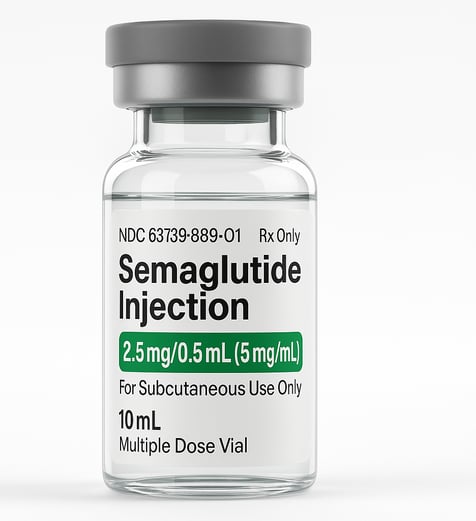

The Lean Athlete’s Dilemma
Getting shredded is hard—really hard. Not just for the average person, but even for seasoned fitness enthusiasts who train hard, track macros, and stay consistent. The physical demands of cutting are one thing, but it’s the mental battle—fighting cravings, resisting binge urges, and surviving weeks of nagging hunger—that often derails even the most disciplined athlete.
Enter semaglutide—a medication originally designed for type 2 diabetes and clinical obesity, now quietly making waves in the fitness community. Better known under the brand names Ozempic and Wegovy, this injectable compound is gaining attention for its powerful appetite-suppressing effects. But here’s the twist: it’s not just being used by people with obesity. More and more fit, healthy, and relatively lean individuals are experimenting with semaglutide as a tool to make cutting phases more manageable, consistent, and sustainable.
In this article, we go beyond the headlines and into the gym—exploring how semaglutide is being used off-label by those pursuing aesthetics rather than medical necessity. Through a real-life story, including a deep-dive interview with fitness enthusiast Sam, we’ll unpack what happens when you use Ozempic not to save your life—but to get in the best shape of it.
Ozempic (Semaglutide) for Fitness
How Lean Athletes Use It to Cut Fat and Control Cravings
What Is Semaglutide, Really?
Semaglutide is a GLP-1 receptor agonist. In simple terms, it mimics the body’s glucagon-like peptide-1, a hormone that:
Slows gastric emptying (you stay full longer)
Reduces appetite (you feel satisfied with less)
Modulates blood sugar (important for diabetic patients)
May even reduce food-related reward signaling in the brain
It was originally launched under Ozempic (for diabetes) and Wegovy (for obesity), with the latter approved at higher weekly doses (up to 2.4 mg).
If you’re new to semaglutide or want a deeper understanding of how it works, check out our comprehensive guide: Semaglutide, Ozempic, and Wegovy The Ultimate Guide to These Powerful Medications
Why Are Fitness Enthusiasts Using It?
1. Appetite Control During a Cut
The number one reason? Hunger suppression. No matter how disciplined an athlete is, maintaining a consistent caloric deficit over weeks or months is mentally taxing. Semaglutide takes the edge off constant cravings, making it easier to stick to macro targets.
2. Blunting the Binge Cycle
In cutting phases, many athletes suffer from “yo-yo weekends” or fall into a restrict-binge cycle. By dulling the intensity of food obsession, semaglutide can act as a buffer during vulnerable moments.
3. Compliance Over Willpower
No compound can replace training and nutrition, but semaglutide may help users stay consistent for longer—especially when willpower is starting to fade.
Who’s Using It? A Look at the Off-Label Community
While official guidelines warn against using semaglutide outside of medical contexts, many in the fitness world are doing just that:

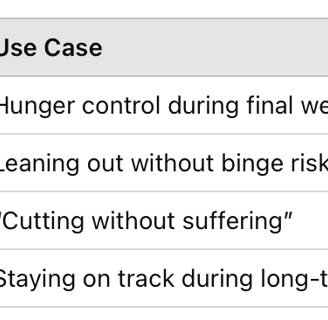
Sam’s Journey: Semaglutide as a Fitness Tool
We spoke with Sam, a passionate fitness enthusiast and amateur strength trainer who, like many in the lifting community, has spent years navigating the fine line between “fit” and “photo-ready.” Sam isn’t overweight, nor diabetic, and certainly doesn’t fall into the typical demographic for semaglutide use. But as someone who trains consistently and understands macros, discipline, and periodization, he was searching for something to help bridge the gap between knowledge and execution—especially during cutting phases.
“I’ve always trained hard and stuck to a decent diet, but getting truly lean takes at least four months of strict meal planning. The problem was, by week six, the hunger and cravings would hit hard—and that’s when I decided to experiment.”
Sam's goals weren’t extreme—just a few kilograms of stubborn fat that always seemed to stand between him and that elusive, crisp definition most fitness lovers chase before summer or a photoshoot. The frustration wasn’t from a lack of knowledge or willpower—it was the mental fatigue of dieting. Constant hunger. Social pressure. Weekend derailments. That voice in your head saying "You’ve earned a break,” which too often turns into a binge.
“I’d stick to my meal plan almost perfectly for the first five or six weeks. But after that, it always got harder. I’d usually shift into a looser routine—still strict from Monday through Friday, but once the weekend hit, it was like I became a different person. I’d justify one small indulgence, and before I knew it, I was elbow-deep in snacks. The guilt would kick in, I’d promise to reset on Monday, and the cycle would start all over again. After crushing it for five or six weeks, sticking to the plan—especially on weekends—got really tough".
The physical effects of this were predictable: stalled progress, water retention, and demotivation. But the psychological effects ran deeper. Sam describes the pattern as a loop of restriction and rebellion—a loop that semaglutide, surprisingly, helped to break.
“I wasn’t looking for a magic pill. I was just tired of white-knuckling through hunger all day, only to snap when the cravings got too loud.”
That’s what led Sam to try semaglutide—not as a weight loss solution, but as a psychological aid. A tool to stay on track without the constant mental grind. Sam approached the experiment cautiously, fully aware that this was off-label use, and committed to keeping everything else dialed in: training intensity, protein intake, hydration, and recovery.
The results, as we’ll explore in the next section, were mixed at first—highlighting a crucial lesson in dosage, timing, and context. But overall, Sam’s journey provides a revealing look into how semaglutide can support—not replace—a disciplined fitness lifestyle.
“This wasn’t about losing weight fast. It was about removing the noise—the constant food chatter in my brain—so I could just follow the plan I already knew would work.”
Attempt 1: Following the Clinical Titration Schedule
Sam’s first experiment with semaglutide didn’t come out of nowhere—it was the result of months of frustration. Despite training consistently and tracking macros, the familiar yo-yo pattern had returned: strict dieting during the week, followed by binge-style eating on the weekends. Over time, those small weekend slips added up in a big way.
“It wasn’t like I lost control for months. I was solid during the week—but the weekends just killed me. Every Monday felt like a reset.”
Eventually, Sam noticed the scale creeping up—5, maybe even 6 kilograms of fat added over just five or six months. While he was far from overweight by medical standards, the extra body fat pushed him noticeably beyond his usual baseline. With a starting point around 12–13% body fat, the gain was enough to blur muscle definition, soften his overall look, and move him well outside his preferred physique range.
“I wasn’t out of shape, but I definitely didn’t feel sharp anymore. My clothes fit tighter, my face looked puffier, and I didn’t like what I saw in the mirror.” I knew it wasn’t muscle. My strength hadn’t changed much, but I looked softer, and I felt sluggish. That’s when I thought, ‘Okay—if there’s ever a time to test semaglutide, it’s now.’”
Determined to approach it methodically, Sam followed the standard medical titration protocol—the same stepwise dosing schedule used for patients with obesity. It seemed like the safest and most reliable approach. After all, Wegovy (approved for weight loss in people with obesity) and Ozempic (used for blood sugar management in type 2 diabetes) both follow a similar dosing strategy: starting low and gradually increasing to a therapeutic level.
Since branded pens were expensive and hard to come by, Sam opted for a generic version of semaglutide, which comes in a lyophilized (freeze-dried) powder form. This required some precision—mixing the powder with bacteriostatic water and using an insulin syringe to measure out weekly injections.
“I did my homework—I wanted to do it ‘right.’ I figured if this schedule worked for people trying to lose 50 kilos, it would be manageable for someone like me who’s just cutting 8 or 10.”
Here’s how the clinical titration played out over the first cycle:
This stepped increase is designed to reduce side effects while gradually ramping up to a therapeutic dose that can suppress appetite and drive significant weight loss in obese patients. The goal in those cases is clear: massive weight reduction with less concern about preserving lean muscle.
“The hunger suppression kicked in fast, especially after the 0.5 mg mark. At first, it was almost welcome—I wasn’t thinking about food constantly. But it didn’t take long before that suppression became too much.”
As Sam progressed to higher doses—especially anything above 1.0 mg—the side effects became impossible to ignore. There was a constant feeling of fullness, even without eating. Meals had to be small and ultra-clean; anything remotely fatty or over 400 kcal sat in the stomach like a brick. Cravings didn’t disappear entirely, but became oddly specific: mostly for simple carbs or sweet things—perhaps the body’s way of begging for quick energy.
“At 1.7 and especially 2.4 mg, I could barely eat. I’d make a bowl of chicken and rice, and two bites in, I was done. I was surviving on snacks—fruit, crackers, protein shakes—but real meals were off the table.”
This put Sam in a nutritional and performance trap:
Training intensity dropped due to inadequate calorie and carb intake
Protein goals became harder to hit, putting lean mass at risk
Digestive discomfort and fatigue started to impact daily functioning
Mood and focus suffered, especially on higher training volume days
“The hunger was gone—but so was my ability to fuel workouts or recover properly. It felt like my body was shrinking, but not in a good way. I didn’t feel ‘ripped,’ I felt depleted.”
The irony? For someone clinically obese, these side effects might be tolerable or even welcome—sacrificing comfort and appetite in exchange for significant health improvements. But for Sam, who was already active, relatively lean, and trying to lose fat without losing performance or muscle, the protocol designed for obesity was simply too aggressive.
Ultimately, Sam maintained the maximum 2.4 mg dose for four weeks before stopping the experiment entirely. The result was weight loss, yes—but it came at a cost Sam wasn’t willing to repeat.

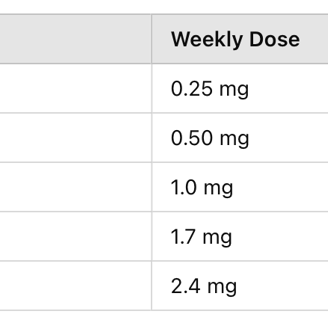
Attempt 2: Fitness-Tailored Low-Dose Protocol
After the physical discomfort and performance drop during the first attempt, Sam decided to take a completely different approach the second time around. Instead of following the clinical titration schedule designed for obesity treatment, he built a fitness-focused protocol tailored for lean individuals aiming to cut body fat while preserving muscle, energy, and sanity.
The guiding principle this time? Start low, stay low, and only increase if necessary.
Sam’s Revised Dosing Schedule:

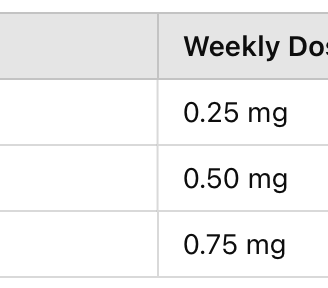
“This was the sweet spot. I wasn’t obsessing about food, could still train hard, and I didn’t feel sick or sluggish. I could stick to my deficit without going crazy.”
From the start, Sam prioritized listening to his body, adjusting only when hunger signals returned or cravings crept back in consistently. The 0.25 mg dose served mostly as a ramp-up phase, allowing the body to adjust to semaglutide’s presence without triggering nausea or bloating.
By weeks five through twelve, 0.5 mg turned out to be highly effective—it took the edge off without completely erasing appetite or turning meals into a chore. For the first time, Sam found himself able to maintain a clean, structured diet without feeling mentally drained or socially isolated.
Training, Nutrition, and the Role of Refeed Days
Crucially, Sam also integrated two refeed or maintenance-calorie days per week, strategically placed around the most intense training sessions. These higher-calorie days helped preserve strength and muscle mass, supported recovery, and provided a mental break from the low-calorie routine.
“With the lower dose, I could still hit 2,800 calories if I needed to. I wasn’t hungry, but I could eat if I had to. That flexibility made all the difference.”
Where higher doses had made it physically uncomfortable to eat more than a few hundred calories at a time, the moderate 0.5–0.75 mg range allowed Sam to eat enough to support performance, without triggering the binge-restrict cycle that often derails cutting efforts.
Training intensity also remained strong during this cycle. Unlike the first attempt—where fatigue and food aversion made workouts feel sluggish—Sam reported feeling energized and capable throughout the day, particularly with consistent meal timing and carb timing around workouts.
“I still trained four to five days a week—strength-focused workouts with some cardio. Semaglutide didn’t make me stronger, but it gave me the mental space to stay consistent without needing to fight cravings 24/7.”
Key Takeaway From Attempt 2:
Sam’s second attempt revealed that lower doses can be more effective for fitness-focused individuals than the full clinical protocol. Hunger didn’t disappear completely—but it became very manageable. The goal wasn’t to eliminate appetite—it was to control it just enough to stick to the plan without suffering or slipping.
This approach ultimately gave Sam the best of both worlds: effective appetite management without the digestive discomfort, loss of performance, or mental fog that had plagued the first cycle.
Summer Maintenance: Letting Go Without Letting It Go
After completing the second semaglutide cycle, Sam decided it was time to hit pause. For about eight months, he stepped away from semaglutide use entirely, allowing his body and metabolism to reset. But this wasn’t just a break from injections—it was a strategic shift in focus.
“I had leaned out pretty well and finally broken that craving-driven cycle. But I knew I couldn’t cut forever. It was time to rebuild—intentionally.”
After completing his cutting cycle, Sam transitioned into a gradual reverse diet, slowly increasing his food intake to give his body time to adjust. Rather than jumping straight into a surplus, he eased his way up over the course of about three weeks until he reached maintenance level—just enough to support his training and energy needs without adding unnecessary fat.
“I didn’t want to rebound or undo all the hard work. So I took my time, listened to my body, and slowly let myself settle into maintenance.”
Throughout the summer, Sam maintained a lean, athletic physique, even though the razor-sharp, photo-ready condition he had at the end of his cut naturally softened a bit. But that was by design. He no longer needed to be stage-lean—just fit, confident, and healthy, with enough flexibility to enjoy life.
“Sure, I lost a little crispness, but I still looked great all summer. And more importantly, I felt good.”
This phase wasn’t about perfection—it was about balance, proving that you can come off a cut, keep your gains, and enjoy the season without swinging back into extremes.
The Winter Rebuild: Lean Bulking With Purpose
After the summer, Sam transitions into a carefully planned lean bulking period—typically starting in the fall and carrying through the winter months. With semaglutide out of his system and hunger returning to normal, this phase allows him to fuel performance, support recovery, and shift his focus toward building quality muscle mass without unnecessary fat gain.
Rather than rushing back into a calorie surplus, Sam gradually increases his intake, giving his body time to adjust to higher food volumes. This controlled approach not only supports lean gains but also reduces the risk of bloating, digestive stress, or post-diet fat rebound.
“It wasn’t like I flipped a switch and started binging. I took it slow, and within a few weeks, I was comfortably eating at maintenance and then a slight surplus.”
The winter bulking phase offers several benefits:
Rebuilding muscle lost during the cut
Resetting appetite and digestion naturally
Improving insulin sensitivity and energy levels with increased carbs
Testing post-semaglutide control and long-term food habits
What surprised Sam the most wasn’t the weight gain—it was the discipline that remained. Even after coming off the medication, he found it easier than expected to maintain healthy habits.
“I was hungrier, sure—but I didn’t lose control. The habits I’d built during the cut were still there. I didn’t feel the urge to eat everything in sight. I could still say no when it mattered.”
This off-cycle phase became more than just a physical reset—it reinforced the idea that semaglutide wasn’t a crutch, but a catalyst. When used with intention, it gave him the mental space and control to break bad habits, build better ones, and carry those patterns into the rest of the year.
Now, with a rhythm of cutting in spring, maintaining through summer, and bulking in winter, Sam has created a sustainable yearly strategy that supports his goals—without the burnout, binge cycles, or extremes that used to derail his progress.
The Annual Rhythm: Cut, Maintain, Build
After refining his approach, Sam settled into a yearly rhythm that aligned perfectly with both his physique goals and lifestyle. Each year, he kicks things off in the spring with a semaglutide-supported cut, dialing in his nutrition and slowly leaning down over the course of 12 to 14 weeks.
Once the cut is complete, Sam transitions into a maintenance phase, increasing his food intake gradually to let his body and digestion adapt without shocking the system. Over about three weeks, he works up to maintenance calories—just enough to maintain energy, support training, and enjoy social events without sacrificing his lean look.
“I don’t rush into a surplus. I give my body time to adjust, then settle into a sweet spot where I can stay lean without obsessing.”
Throughout the summer months, Sam lets go of the ultra-shredded, crisp conditioning he achieves at the peak of his cut. But he stays in excellent shape—fit, athletic, and confident, with enough dietary freedom to live life without the rigidity of a competition prep.
Then, as autumn rolls in, he shifts gears again—moving into a lean bulk for the fall and winter, where strength, performance, and muscle growth become the focus. No semaglutide during this phase—just consistent training, structured eating, and higher calories to fuel progress.
“It’s a cycle I’ve repeated for a few years now: cut in the spring, maintain through summer, then build during the winter. It keeps me lean when I want to be, strong when I need to be, and mentally balanced year-round.”
By treating semaglutide as a strategic tool, rather than a constant crutch, Sam has found a way to make physique goals sustainable—without burning out or yo-yoing between extremes.
Red = Cutting
Blue = Maintenance
Green = Bulking

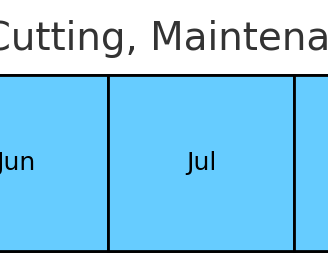
Sam’s Approach: Starting Low and Increasing Slowly
“Start slow and go slow. There’s no rush to jump into higher doses—especially if your goal isn’t extreme fat loss but sustainability and muscle retention.”
One of the key things Sam learned is that the effectiveness of any given dose tends to diminish over time. A 0.5 mg weekly dose might work great for several weeks—or even months—for some, while others may notice hunger returning after just a few weeks.
That’s why the smartest approach is to stay at a dose as long as it’s working. There’s no need to increase just because a schedule says so. Once you notice that hunger or cravings are creeping back in—and not just due to emotional factors—then a small bump in dosage may be warranted.
But with higher doses come trade-offs: more nausea, digestive discomfort, fatigue, and difficulty hitting caloric or protein targets. So progression should always be gradual and need-based.
The key takeaway? Personalization is everything. Semaglutide is not a one-size-fits-all solution—it’s a hunger management tool. Used properly, it can help you stay on plan long enough to actually see results—without hating the process.
As interest in GLP-1s continues to grow beyond the medical world, it’s likely we’ll see more experimentation—and hopefully, more data—on how compounds like semaglutide can be used not just to lose weight, but to sustain lean, high-functioning bodies without the misery of constant hunger.
Just don’t forget: training, nutrition, sleep, and consistency still carry the most weight—literally and figuratively.
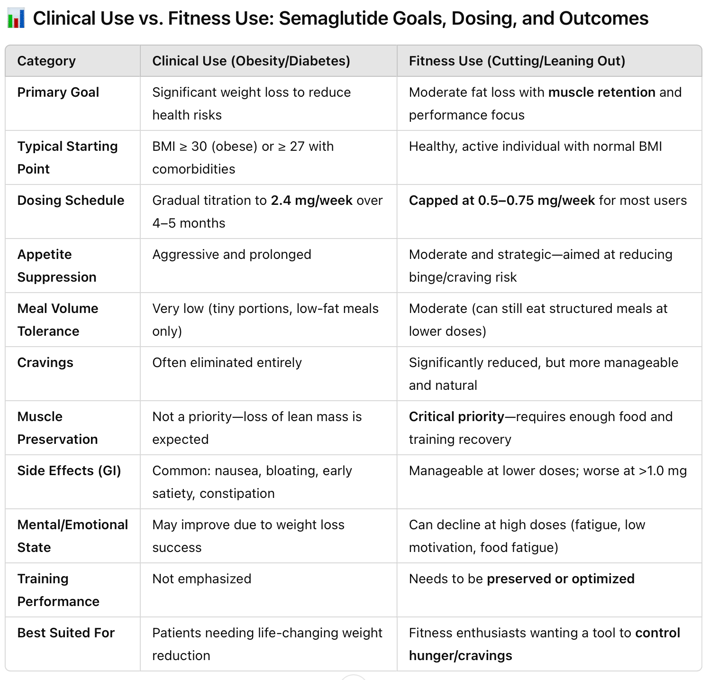

Understanding the Different Goals: Medical Treatment vs. Performance Strategy
While semaglutide was originally designed for medical use—particularly for individuals with obesity or type 2 diabetes—its adoption in the fitness world has created two very different use cases with vastly different goals.
In a clinical context, semaglutide is prescribed to reduce body weight rapidly and significantly, primarily to improve metabolic health and reduce obesity-related risks. The dosing strategy is aggressive by necessity, aiming for maximum appetite suppression, even if that means sacrificing lean mass or physical performance in the short term.
By contrast, fitness-minded users are typically already active and relatively lean. Their goals aren’t to lose 20+ kilograms but to drop a few percentage points of body fat while maintaining muscle mass, strength, and energy levels. For them, semaglutide isn’t a last-resort weight loss medication—it’s a compliance tool, used strategically to manage hunger, curb cravings, and maintain consistency through a structured cutting phase.
These differences in intent lead to very different protocols, outcomes, and side effect profiles. The table below highlights some of the key distinctions between clinical use and fitness use of semaglutide:
Summary
Clinical semaglutide use is designed to suppress appetite as much as possible, even if that means sacrificing muscle, performance, or food enjoyment.
Fitness use, by contrast, is about finding the lowest effective dose that controls appetite without undermining training or nutrition goals.
“It’s not about losing weight fast. It’s about keeping my head clear, sticking to the plan, and making consistent progress without burning out.” — Sam
Final Thoughts: Is Ozempic the Future of Fitness Cutting?
Sam’s experience sheds light on what many fitness-minded individuals are discovering: semaglutide can be a powerful tool for managing hunger, improving diet adherence, and making cutting more sustainable—when used thoughtfully.
However, it’s crucial to recognize that not everyone reacts the same way to semaglutide. For Sam, a weekly dose of 0.5 to 0.75 mg was more than enough to suppress cravings and maintain control without negatively impacting performance or nutrition. But that doesn’t mean this range is ideal for everyone.
We’ve received feedback from users across the spectrum: some found 0.5 mg to be the sweet spot, while others reported that semaglutide only became effective for them at doses closer to 1.0–1.25 mg or even higher.
That said, the general consensus among non-obese fitness users seems to fall within a range of 0.5 to 1.25 mg per week. Within this window, most users report significant appetite control with manageable side effects—especially when paired with a structured nutrition and training plan.




